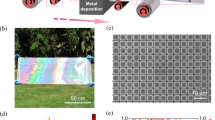Abstract
The work presented in this study is concerned the development of a new solar cell prototype in order to improve photovoltaic efficiency In this model we show that the material can have five and more successive incident ray absorptions instead of three currently, where we changed the direction of the reflected ray, by varying the angle between the two neighbouring pyramids, the incidence angle, the opening between the heads of the two closest pyramids and their height. Thus, with an angle between the two neighbouring pyramid varying between 24° and 12° and for angle of incidence varying between 78° and 84°. For these values of the angle between the two neighbouring pyramids and incidence angle, the opening between the heads of the two closest pyramids varied respectively from 4.25 to 2.10 μm for a pyramid height of 10 μm. This lead to a substantial increase of the spectral response and the photovoltaic efficiency.
Similar content being viewed by others
References
L. A. Dobrzański and A. Drygała, “Surface texturing of multicrystalline silicon solar cells,” Journal of Achievements in Materials and Manufacturing Engineering 31, 77–81 (2008).
M. Lipinski, P. Zieba, and A. Kaminski, “Crystalline silicon solar cells,” in Foundation of Materials Design (Research Signpost, 2006), pp. 285–308.
D. K. Ferry and J. P. Bird, Electronic Materials and Devices (San Academic Press, Diego, 2001).
R. E. Hummel, Electronic Properties of Materials (Springer-Verlag, New York, 2001).
E. Fornies, C. Zaldo, and J. M. Albella, “Control of random texture of monocrystalline silicon cells by angle-resolved optical reflectance,” Solar Energy Materials and Solar Cells 87, 583–593 (2005).
M. A. Gonsalvez and R. M. Nieminen, “Surface morphology during anisotropic wet chemical etching of crystalline silicon,” New Journal of Physics 5, 100.1–100.28 (2003).
J. D. Hylton, A. R. Burgers, and W. C. Sinke, “Alkaline etching for reflectance reduction in multicrystalline silicon solar cells,” Journal of The Electrochemical Society 151, 408–427 (2004).
J. Nijs, S. Sivoththaman, J. Szlufcik, K. De Clercq, F. Duerinckx, E. Van Kerschaever, R. Einhaus, J. Poortmans, T. Vermeulen, and R. Mertens, “Overview of solar cell technologies and results on high efficiency multicrystalline silicon substrates,” Solar Energy Materials and Solar Cells 48, 199–217 (1997).
H. Seidel, L. Csepregi, A. Heuberger, and H. Baumgartel, “Anisotropic etching of crystalline silicon in alkaline solution,” in Orientation Dependence and Behavior of Passivation Layers, Journal of the Electrochemical Society 137/11, 3612–3626 (1996).
P. Panek, M. Lipiski, and J. Dutkiewicz, “Texturization of multicrystalline silicon by wet chemical etching for silicon solar cells,” Journal of Materials Science 40/6, 1459–1463 (2005).
V. Y. Yerokhov, R. Hezel, M. Lipinski, R. Ciach, H. Nagel, A. Mylyanych, and P. Panek, “Cost-effective methods of texturing for silicon solar cells,” Solar Energy Materials and Solar Cells 72, 291–298 (2002).
K. Fukui, Y. Inomata, and K. Shirasawa, “Surface texturing using reactive ion etching for multicrystalline silicon solar cell,” in Proceedings of the 26th IEEE Photovoltaic Specialists Conference, PVSC’97 (Anaheim, 1997), pp. 47–50.
P. Fath, C. Marckmann, E. Bucher, and G. Willeke, “Multicrystalline silicon solar cells using a new high throughput mechanical texturization technology and a roller printing metallization technique,” in Proceedings of the 13th European PV Solar Energy Conference (Nice, 1995), pp. 29–32.
C. Gerhards, C. Marckmann, R. Tolle, M. Spiegel, P. Fath, and G. Willeke, “Mechanically V-textured low cost multicrystalline silicon solar cells with a novel printing metallization,” in Proceedings of the 26th IEEE Photovoltaic Specialists Conference, PVSC’97 (Anaheim, 1997), pp. 43–46.
D. B. Rudenberg, “High efficiency silicon solar cells,” in Proceedings of the 14th Annual Power Sources Conference. U.S. Army Signal Research and Development Lab, 1960, p. 22.
J. A. W. Zhao, A. W. X. Dai, M. A. Green, and S. R. Wenham, “Improvements in silicon solar cell performance,” in Proceedings of 22nd IEEE PV Specialists Conference, 1991, pp. 399–402.
S. R. Wenham and M. A. Green, Buried Contact Solar Cell, http://www.freepatentsonline.com/4726850.html.
J. C. Zolper, S. Narayanan, S. R. Wenham, and M. A. Green, “16.7% efficient, laser textured, buried contact polycrystalline silicon solar cell,” Applied Physics Letters 55, 2363 (1989), http://apl.aip.org/applab/v55/i22/p2363-s1.
S. C. Baker-Finch, K. R. McIntosh, and M. L. Terry, “Isotextured silicon solar cell analysis and modeling 1: optics,” IEEE Journal of Photovoltaics 2(4), 457–464 (2012).
P. Campbell and M. A. Green, “Light trapping properties of pyramidally textured surfaces,” Journal of Applied Physics 62,(1), 243 (1987).
P. Campbell and M. A. Green, “High performance light trapping textures for monocrystalline silicon solar cells,” Solar Energy Materials and Solar Cells 65(1–4), 369–375 (2001).
A. Ricaud, Photopiles Solaires (Presses Polytechnique et Universitaires Romandes, 1997), pp. 195–198.
A. Hamel, B. Hadjoudja, and A. Chibani, “Possible improvement of solar cell efficiency,” Phys. Part. Nucl. Lett. 7(4), 281–284 (2010).
Author information
Authors and Affiliations
Corresponding author
Additional information
The article is published in the original.
Rights and permissions
About this article
Cite this article
Hamel, A. The influence of the opening between the heads of the two closest pyramids in textured surface for solar cells and its application on the spectral response. Phys. Part. Nuclei Lett. 11, 282–285 (2014). https://doi.org/10.1134/S1547477114030091
Published:
Issue Date:
DOI: https://doi.org/10.1134/S1547477114030091




